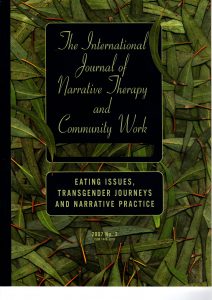 Dear Reader,
Dear Reader,
G’day and welcome to this issue of the International Journal of Narrative Therapy and Community Work.
Before introducing the papers that appear in this issue, we would like to thank those readers who offered us feedback on the previous issue Experience Consultants. It seems that the papers in this last issue were very highly regarded by many who read them. We always welcome readers’ feedback. If the papers you read here bring enjoyment or irritation, challenge or frustration, we would be interested to hear your thoughts. Similarly, if there are particular topics that you would like to read more about, please let us know. Thanks!
We’re also keen to hear about your experiences of trying to engage with narrative practices in your own ways and contexts. In coming months, we hope to be publishing papers that represent a plurality of narrative practice. There are many different ways of engaging with a narrative metaphor within therapeutic and/or community practice. We are on the look-out for quirky and diverse forms of narrative practice.
This particular issue of the journal consists of papers from the USA, Bangladesh, Australia, UK, Norway and Canada. The diversity of countries is matched by a diversity of topics.
Eileen Hurley describes her use of narrative documents in work with young men in a US jail. Maksuda Begum conveys stories of her work in Dhaka, Bangladesh, in which she speaks with children with disabilities and their mothers. An alternative intake questionnaire informed by narrative ideas, which was developed by David Denborough in collaboration with Maksuda Begum, is also included.
Due to requests from readers, we have then included two papers about the use of narrative practices in responding to eating issues. Shona Russell describes ways in which narrative conversations can contribute to a deconstruction of perfectionism, while Tracy Craggs and Alex Reed provide a novel account of therapy for anorexia.
The final section of this issue focuses on transgender experience and possibilities for practice. Jodi Aman provides an account of therapeutic work with a young person whose journey to gender belonging involved moving from identifying as a young woman, to identifying as a young man. Julie Tilsen, David Nylund and Lorraine Grieves then combine theoretical understandings with practice examples of conversations with lesbian women whose partners are transitioning from female to male gender identities. While Aya Okumura documents the stories of male to female transgender journeys of getting through tough times. Significantly, Aya also provides a framework of questions that practitioners could use in a range of other counselling or therapeutic contexts. This section is then completed with a reflection by Esben Esther Pirelli Benestad, an influential Norwegian bi-gender doctor.
We hope the diversity of papers within this issue will spark thoughts and developments in your own practice. And we look forward to your feedback and suggestions.
Warm regards,
Cheryl White

 Dear Reader,
Dear Reader,